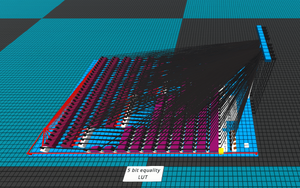Lookup Table: Difference between revisions
clarify wording |
Made it much simpler by removing some wording. Added a LUT definition using a template. Made formulas clearer. |
||
| Line 1: | Line 1: | ||
Any arbitrary logic formula can always be represented in [[wikipedia:Disjunctive_normal_form|Disjunctive normal form]]. Put in simple terms, | Any arbitrary logic formula can always be represented in [[wikipedia:Disjunctive_normal_form|Disjunctive normal form]]. Put in simple terms, the output of the formula is computed using a single OR operation on its inputs coming from a number of AND gates. Each AND gate represents a distinct case where the output is supposed to be ''true''. | ||
[[File:5BitEqualityLut.png|alt=5 bit equality LUT|thumb|5 bit equality LUT]] | [[File:5BitEqualityLut.png|alt=5 bit equality LUT|thumb|5 bit equality LUT]] | ||
{{LUT}}. | |||
== Construction == | |||
A LUT is implemented by first creating a list of all input combinations that should lead to a ''true'' output. From this list, the LUT can then be built quite easily. | |||
It consists of multiple relay chains that are simply OR-ed together at the end, where one chain corresponds to one input-assignment that should lead to a truthy output value. The aforementioned relay chains are started by a single NOT-gate whose inputs are all signals that are ''false'' in the case where a ''true'' output is expected, followed by a set of relays where the top input is expected to be ''true'' for such a ''true'' result. | |||
We can avoid delays by not using [[Buffer|buffers]], it will make circuit perform the operation in a single tick! | |||
== Complexity == | In that case, back-propagation must be prevented by using [[Fast-Buffers|fast-buffers]]. | ||
When | In this case each chain needs one component per input (relays plus fast-buffers), along with one NOT-gate if there are any inputs that are supposed to be ''off''. | ||
=== Complexity to build === | |||
When building a LUT as described above, we can count the total number of components as: | |||
:<math>C = c \cdot (1 + n)</math> | |||
Where: | |||
<math>c</math> is the number of distinct '''chains''' (true outputs),<br> | |||
<math>n</math> is the number of inputs. | |||
Let's assume half of all possible input combinations lead to a true output: | |||
:<math>c = 50%( 2^n) = 2^{n-1}</math> | |||
So in total: | |||
:<math>C = 2^{n-1} \cdot (1 + n)</math> | |||
In theory it's asymptotically approaching : <math>\mathcal{O}(2^n)</math> | |||
In other words, the required component count grows exponentially with the number of inputs, assuming the number of true-output cases also scales exponentially. | |||
While LUT circuits become very expensive in terms of components, they are the '''extremely fast''', producing an output in a single tick regardless of input size. This makes them essential for designs that must run within strict time limits. For non-trivial functions, this speed is usually only achievable by using a LUT. | |||
{{todo|add infobox giving an overview of time and component count maybe?}} | {{todo|add infobox giving an overview of time and component count maybe?}} | ||
Revision as of 17:27, 7 September 2025
Any arbitrary logic formula can always be represented in Disjunctive normal form. Put in simple terms, the output of the formula is computed using a single OR operation on its inputs coming from a number of AND gates. Each AND gate represents a distinct case where the output is supposed to be true.

- Lookup table
- In Logic World, a Lookup table (LUT) is a circuit that explicitly encodes all possible input cases and assigns a specific output to each case.
- The output may be a single bit or a pattern of bits.
- Examples:
- read-only memory (ROM) (general example)
- storing characters for a screen (particular example)
- a hard-coded complex formula.
Construction
A LUT is implemented by first creating a list of all input combinations that should lead to a true output. From this list, the LUT can then be built quite easily. It consists of multiple relay chains that are simply OR-ed together at the end, where one chain corresponds to one input-assignment that should lead to a truthy output value. The aforementioned relay chains are started by a single NOT-gate whose inputs are all signals that are false in the case where a true output is expected, followed by a set of relays where the top input is expected to be true for such a true result.
We can avoid delays by not using buffers, it will make circuit perform the operation in a single tick! In that case, back-propagation must be prevented by using fast-buffers. In this case each chain needs one component per input (relays plus fast-buffers), along with one NOT-gate if there are any inputs that are supposed to be off.
Complexity to build
When building a LUT as described above, we can count the total number of components as:
Where:
is the number of distinct chains (true outputs),
is the number of inputs.
Let's assume half of all possible input combinations lead to a true output:
So in total:
In theory it's asymptotically approaching :
In other words, the required component count grows exponentially with the number of inputs, assuming the number of true-output cases also scales exponentially.
While LUT circuits become very expensive in terms of components, they are the extremely fast, producing an output in a single tick regardless of input size. This makes them essential for designs that must run within strict time limits. For non-trivial functions, this speed is usually only achievable by using a LUT.

